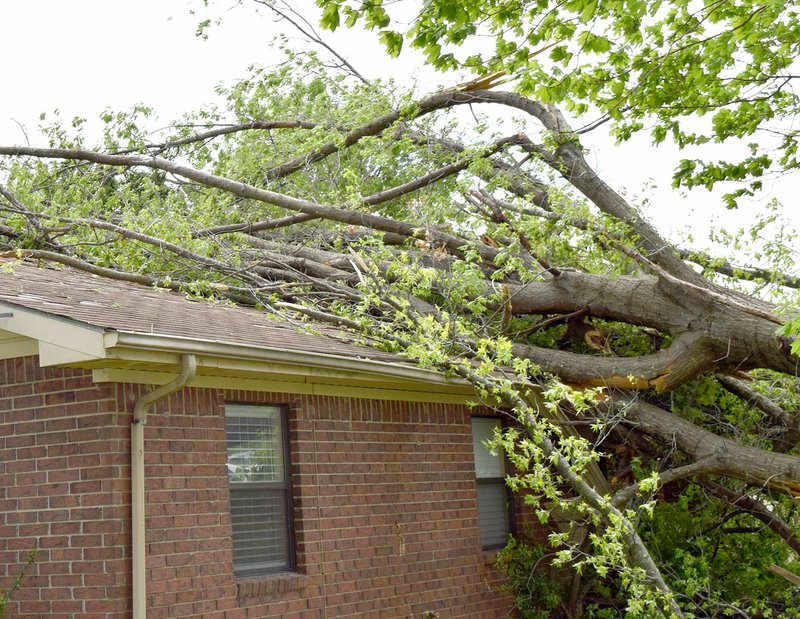DECATUR — The 2016 tornado season roared into Decatur a little early as a line of tornadic thunderstorms moved through the area April 26-27, prompting a series of tornado warnings that extended from eastern Oklahoma into Benton and Washington counties.
Tornado warnings were posted for Delaware and Adair Counties in Oklahoma 30 minutes prior to the storms crossing the border into Arkansas.
Several areas of rotation were indicated by Doppler radar along a line of storms that stretched from southwest Missouri to northeast Texas, moving east at around 50 miles an hour.
At 12:01 a.m. April 27, the National Weather Service issued a tornado warning for southeastern Delaware County in Okla. that included the communities of Colcord, Kansas and Twin Oaks. The warning was allowed to expire at 12:15 a.m. The next tornado warning was issued at 12:40 a.m. for northeastern Benton County until 1:15 a.m, just before the storm hit Centerton, which was included in the list of communities effected by this storm.
In a perfect example of a storm recycling, the storm in Delaware County had dissipated as it moved into western Benton County. That area of rotation reformed just west of Decatur in a matter of minutes, leaving little time for the Weather Service to issue another warning at the time. The fast moving storm was between Decatur and Centerton before the Weather Service issued the tornado warning for northeastern Benton County.
Since there were no active tornado warnings at the time, city officials did not engage the tornado sirens.
At the time, the dangerous storm formed into a tornado just northeast of the city, cutting a path about two miles long through Crystal Lake Estates, Crystal Lake airport and Crystal Lake park and continued across the lake and up the north slope and over toward Turkey Ridge Road before lifting briefly and reforming near Centerton.
National Weather Service officials classified the debris signature as that of an EF-1 tornado. The Enhanced Fujita (EF) scale is used to measure the wind speeds and damage signatures of tornadoes with EF-O being the weakest and EF-5 being the strongest. An EF-1 is capable of producing wind speeds between 86 and 110 miles an hour.
A massive oak tree was blown onto the roof of the guest house of Crystal Lake Estates, which is next to the park. One man and his dog were in the house at the time. The man was asleep and was awakened by a loud roar only moments before the storm hit. He went to the front door to let his dog into the house. He had only seconds to retrieve pillows from his bedroom and crawl into the bath tub before the tree smashed through the roof and into the living room. Both he and the dog walked away with only minor injuries.
Trees were also uprooted near the Peterson and Evans homes near the south central part of airport and near the top of the hill.
Two 100-year-old trees were uprooted at Crystal Lake park. One fell across the boat dock. The other toppled over into the water, dislodging three concrete sidewalk panels as it fell. The tornado severely damaged several of the pine trees that line the fence going into the airport. The wind sock at the Crystal Lake Airport, which sustained previous damage several months ago, had parts of it blown away from its supporting structure. An airport information sign was also ripped from its support structure and blown into the fence near the row of pine trees. Parts of the sign were later retrieved from the lake.
There is no estimate of the damage to the house or the park. The Decatur street department began clearing debris from the park April 28 and expected to have it cleared by the first week of May.
With tornado season now upon us, it is important to have a disaster plan in place. Know where to go in case a tornado warning is in the area. Make sure to have a NOAA radio with extra batteries available to listen for the latest weather statements from the National Weather Service.
It is also important to know the difference between a watch and a warning. A tornado watch means that conditions in the atmosphere are right for the formation of tornadoes in the area. A warning means that a tornado has been spotted by either the public, storm chasers, law enforcement or Doppler radar.
Knowing what to do, in the case of the man at Crystal Lake, and where to go in the event of a tornado could mean the difference between life or death.

